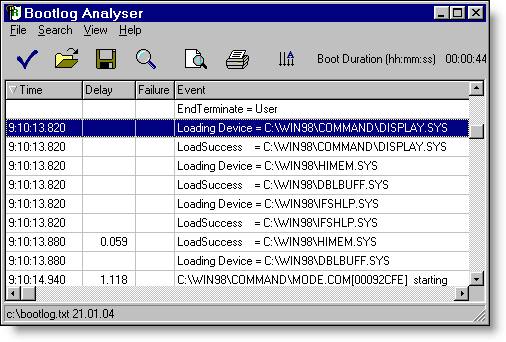Troubleshoot Windows startup/shutdown with Bootlog Analyser
Bootlog Analyser allows troubleshooting of Windows startup and shutdown with Windows 95/98/Me/NT4/2000/XP.
Bootlog Analyser uses the Windows generated startup log file (bootlog.txt or ntbtlog.txt).
Bootlog.txt file records the progress of the Windows startup (boot) process.
It is created if you request a logged boot, and is also created automatically by Windows if Windows detected that the previous boot was unsuccessful.
You can create a new Boot Log file by choosing option [2] "Logged (\BOOTLOG.TXT)" from the Windows 95 Startup Menu. You can display this menu manually by pressing the F8 (or CTRL) key during system startup, just after the system beep and before the Windows logo appears.

Press on the tick button to read current Bootlog file. Usually it is located in the c:\bootlog.txt (Windows 9X/Me) or in the c:\windows\NTBTLOG.TXT(Windows NT4/2000/XP).
Choose File-Open to open file from another location.
You can see used file name and its date in the status bar at the bottom of the window.
Boot duration parameter determines how long the Windows startup process runs.
To analyse the failures click on the Failure column and go to the top of the list.
The failed items are marked by "!!!" signature.
